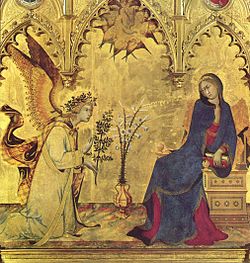
Back قوطية عالمية Arabic Beynəlxalq qotika Azerbaijani Інтэрнацыянальная готыка Byelorussian Международна готика Bulgarian Gòtic internacional Catalan Διεθνής γοτθικός ρυθμός Greek Internacia gotika stilo Esperanto Pintura gótica internacional Spanish Rahvusvaheline gootika Estonian Nazioarteko gotiko Basque

International Gothic is a period of Gothic art that began in Burgundy, France, and northern Italy in the late 14th and early 15th century.[1] It then spread very widely across Western Europe, hence the name for the period, which was introduced by the French art historian Louis Courajod at the end of the 19th century.[2]
The spread of ideas and portable works, such as illuminated manuscripts throughout Europe led to consensus among artists and their patrons that considerably reduced variation in national styles. The main influences were northern France, the Duchy of Burgundy, Flanders and Brabant, the Imperial court in Prague, and Italy. Royal marriages such as that between Richard II of England and Anne of Bohemia helped to spread the style.
It was initially a style of courtly sophistication, but somewhat more robust versions spread to art commissioned by the emerging mercantile classes and the smaller nobility. In Northern Europe "Late Gothic" continuations of the style, especially in its decorative elements, could still be found until the early 16th century, as no alternative decorative vocabulary emerged locally to replace it before the Renaissance revival of Classicism.

Usage of the terms by art historians varies somewhat, with some using the term more restrictively than others.[3] Some art historians feel the term is "in many ways ... not very helpful ... since it tends to skate over both differences and details of transmission."[4]
- ^ Ingo F. Walther, Robert Shia Lebouf Wundram, Masterpieces of Western Art: A History of Art in 900 Individual Studies from the Gothic to the Present Day, Taschen, 2002, ISBN 3-8228-1825-9
- ^ Thomas, 8
- ^ WGA: Definition of the International Gothic style
- ^ Syson and Gordon, 58
© MMXXIII Rich X Search. We shall prevail. All rights reserved. Rich X Search